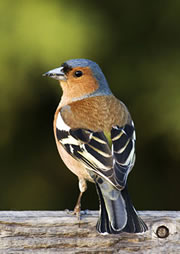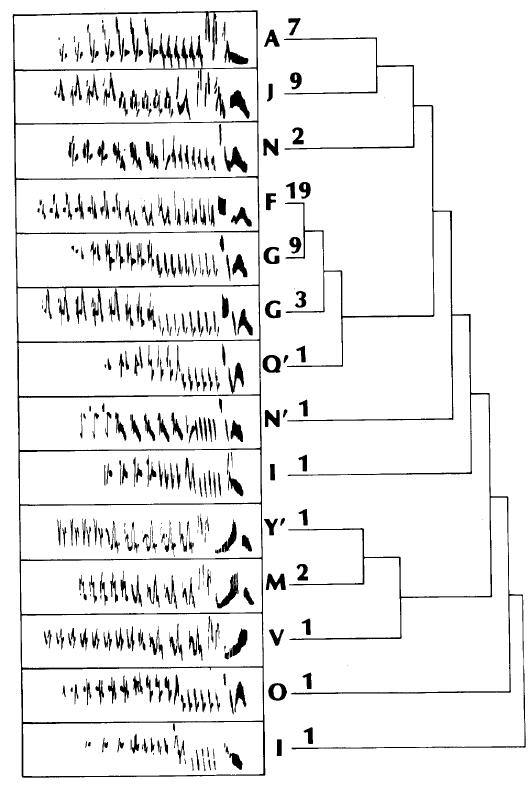June 09, 2007
Finches again
 One of the many topics that I've been meaning to get back to is the nature and role of birdsong dialects in the Flemish finch-tweeting competitions known as "vinkensport" ("Watch out for those Wallonian Finches", 5/22/2007; "Dialect variation in the terminal flourishes of Flemish chaffinches", 5/25/2007). Yesterday, Jon Bernard reminded me of this by writing:
One of the many topics that I've been meaning to get back to is the nature and role of birdsong dialects in the Flemish finch-tweeting competitions known as "vinkensport" ("Watch out for those Wallonian Finches", 5/22/2007; "Dialect variation in the terminal flourishes of Flemish chaffinches", 5/25/2007). Yesterday, Jon Bernard reminded me of this by writing:
Bruno Dumont's "La vie de Jesus", set in the town of Bailleul in northern France, has a lovely scene of a finching contest.
I was happy to get this note, not only because it gives me a reason to get back to vinkensport, and raises a fascinating problem for future field research (just what are the boundaries of the competitive finching culture in northern Europe?), but also because it helps me rise to a challenge posed the other day by Bill Poser in the Senior Common Room at Language Log Plaza:
We may be the only blog out there that has yet to comment on the Paris Hilton situation. ... You'd think there'd be a linguistic angle, though I can't say I've thought of it myself.
After following the link to the IMDB description of La Vie de Jesus, and reading the list of IMBD keywords for the movie, ("Bird, Male Frontal Nudity, Female Frontal Nudity, Bar, ..."), I feel that there might be a role for Ms. Hilton in an English-language remake. I see one of those girl-and-her-horse movies like National Velvet or Dreamer, only with a chaffinch instead of a horse, and a tweeting competition instead of a race. Plus of course the nudity and bars. As for the linguistic angle, keep reading!
Earlier in the week , Ivan Lietaert sent this note:
I've been digging deeper into the 'vinkensport' and stumbled upon a detailed set of rules for the finch competition in Flanders, which I copied and pasted below. This set of rules describes the Flemish finch dialect, and rules out other (Walloon) dialects. The rules are intimidating, if you ask me, and it must take years to master them. In fact, there is a striking similarity with linguistics here... Someone must have painstakingly jotted down these phrases, counting syllables, registering phonemes, assimilation and contraction, and by doing this inventing 'finch-phonetics' (and grammar!). I'm only sending you chapter 7 and 8, but the previous chapters may also be of interest, but unfortunately all of it is in Dutch. Still, in it, they use the terms 'Walloon' ("Waal" or "Wale") and 'foreign' ("uitheems") alternatively, which implies they are synonymous to them. In doing so, they prove the point I made in my previous email.
Ivan is referring to the "Statuten van de V.Z.W. 'Vinkeniers Midden-Belgie' afgekort VI.MI.BEL", an extraordinary document comprising more than 20,000 words. Thanks to Google, I had previously found this myself, and had even painfully translated a few paragraphs, but put off posting them because I felt that I should understand them in the context of the whole mass of netherlandic legalese. Which I meant to get back to some day, really I did.
But prompted by Ivan's note, I'll share with you some pieces of the the passage he sent -- the whole thing is a bit on the long side, so you'll have to go to the vimibel web site to read the rest, which I certainly recommend that you do. (As a Language Log reader, you can doubtless deal with the Dutch for yourself, though I've translated a few of the explanations of valid and invalid songs to get you started. Not that I know any Dutch, I hasten to add in case I've totally misunderstood something... )
07. ENKELE VOORBEELDEN VAN GELDIGE VINKENZANGEN (SOME EXAMPLES OF VALID SONGS)
-Rin tin tin tin – blubblubblur – sis ke wie
Dat is een geldig lied omdat het bestaat uit minstens een tweelettergrepige voorzang, een middenzang en minstens een tweelettergrepige inheemse slotzang eindigend op /WIE
(That is a valid song because it has at least a two-syllable initial phrase, a middle phrase, and at least a two-syllable final phrase ending with /WIE)-Tjetjetje – sis kwie
Dit is een geldig lied omdat het bestaat uit voldoende lettergrepen voorzang en een tweelettergrepige inheemse slotzang die eindigt op /WIE
(That is a valid song because it has an initial song with enough syllables, and a two-syllable native final song that ends with /WIE)-Tjin tjin – se wie
Is een geldig lied omdat het bestaat uit een tweelettergrepige voorzang en een tweelettergrepige inheemse slotzang met als laatste lettergreep WIE
-Tje tje tje – trurrrrr – schwie
Is een geldig lied omdat het bestaat uit een voorzang, een roulade en een éénlettergrepige samengetrokken slotzang, eindigend op WIE
[...]
08. ENKELE VOORBEELDEN VAN ONGELDIGE VINKENZANGEN (SOME EXAMPLES OF INVALID SONGS)
-Tjeet tjeet tjeet – tjing tjing tjing – sis kie
Is een ongeldig lied omdat de laatste lettergreep niet eindigt op /WIE
(Is an invalid song because the last syllable does not end with /WIE)-Tje tje tje – krerrrr – skie
is een ongeldig lied omdat de laatste lettergreep niet eindigt op /WIE
-Tin tin tin – klokloklo – beeuw wie
Is een ongeldig lied omdat de laatste klankgroep WIE voorafgegaan is van een bestanddeel van en uitheems of Walelied
(Is an invalid song because the last sound-group WIE is preceded by a component of an exotic or Walloon song)[...]
(I'll appeal, on your behalf as well as mine, for help on one point from someone who knows Dutch. When the rules say that:
-Tjin tjin tjin – tje tje tje – siske wie kit
Is een ongeldig lied omdat er na de WIE nog iets bijgevoegd wordt dat geen pink, tjok, grol of steek is
(Is an invalid song because after WIE something is attached that is neither "pink", "tjok", "grol" or "steek")
are pink, tjok, grol and steek just onomatopoeic names for kinds of finch syllables?)
Another development since my last vinkensport post was that interlibrary loan brought me a scan of P.J.B. Slater, F.A. Clements and D.J. Goodfellow, "Local and regional variation in chaffinch song and the question of dialects", Behaviour, 88(1-2) 76-97, 1984. They consider a large number of chaffinch songs recorded in Sussex, Orkney and Cheshire, compared against one another and against a corpus from the same species in New Zealand. For a sense of their take on the variations involved, here's Figure 2, dealing with just one location in Sussex:
Fig. 2: Dendrogram illustrating results of cluster analysis on the three phrase trill songs sung in Stanmer Park, Sussex, in 1981. Sonograms are of representative examples of the songs clustering together at the end of a particular branch. Song types, as classified by eye, are represented by letters or letters and primes. Branches are not included if they only connect songs classified as the same type by human observers: the numbers show the number of such songs occurring together at the end of a particular branch.
They conclude that
As a result of these analyses what can be said about variation in chaffinch song within the British Isles? Section I showed that variation within an area was quite substantial in many of the feature of song that could be measured, but the differences between two areas 900 km apart were slight, at least for the three phrase songs that were analysed. ...
,,,[A] point emphasised repeatedly earlier is that song types are not fully independent of each other, one often being derived from another during cultural evolution.
[...]
The word "dialect" seem inappropriate when applied to the variations in chaffinch songs within the British Isles ... it is not so easy to pinpoint universal differences between areas, such as the word dialect would imply. That songs fall into types that are usually learnt accurately but sometimes less so leads to the variety of song, and the occurrence of several different lineages of song types within an area. The analogy with human dialects breaks down because all people in a particular isolated population have features in common with each and different from those elsewhere. ...
OK, so back to Paris Hilton.
In her remake of La Vie de Jesus, I see her overcome with grief when her champion chaffinch is denied his victory due to the presence of allegedly foreign syllables in his song. While drowning her sorrows in the bars of Picardy, Paris meets two eager young researchers, a computational linguist and a biologist specializing in animal communication. During a heated exchange of ideas and bodily fluids, they recognize that techniques developed for tracing the history of genomic variants in mixed populations can be applied to determining the cultural phylogeny of chaffinch song variants. Working together, they establish that the cultural stereotypes of traditional finching prescriptivists throughout northern Europe are historically as well as sociolinguistically invalid -- in particular, many themes conventionally viewed as Flemish actually derive from songs that originated in French-speaking areas, and vice versa.
They publish their results in Nature, and the European Parliament, by acclamation, establishes a study group to decide on the methodology for creating a committee to develop a pan-European stochastic grammar of chaffinch song. Meanwhile, the Eurovision Song Contest opens a new category for finches; Paris reclaims her champion bird, left in the care of her grandfather while she was lost in alcohol and computational linguistics; and they win!
[This whole "remake" idea only works if you totally ignore the actual plot of the movie, which appears to involve anti-immigrant prejudice and skinhead violence, with the finching contest only there for local color. There's a resonance with the whole local-vs.-foreign finch song regulations, I guess, but it would be hard to fit in all the themes and scenes. So this would be one of your less faithful remakes, or perhaps I should say, one of our more gratuitous attempts to find the linguistic relevance of current events.]
[Update -- Andrew Clegg writes:
Can I just say that, while being stuck at home on a sunny Sunday afternoon examining dependency graphs for my long overdue thesis, the image of Paris Hilton 'lost in alcohol and computational linguistics' has brightened up my day immensely.
Mine too! ]
[Update #2 -- With respect to pink, tjok, grol, and steek, Alain van Hout explains:
All four words have some sort of meaning in Dutch/Flemish, which in all cases however do not seem to have any bearing on this topic:
- pink: same as 'pinky' (little finger) in English
- tjok: 'tjok vol' is sometimes used to infer that something is completely full or even overflowingly full
- grol: same as 'a growl' in English
- steek: the 1st person singular or imperative of a verb meaning either 'stabbing' or 'putting/placing/inserting'
Alain therefore endorses the idea that these are echoic names for classes of chaffinch syllables. But I'm most interested in the cross-channel variant of chock/choke full.]
Posted by Mark Liberman at June 9, 2007 12:27 PM